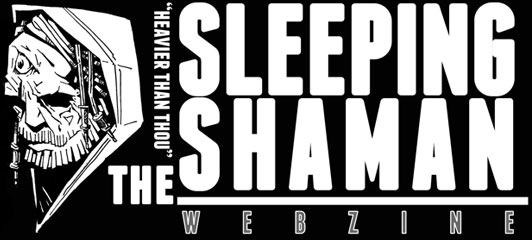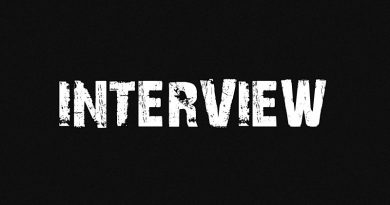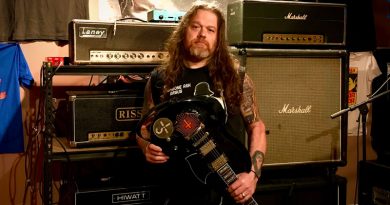In Search Of Tone: Mike Sullivan Of Russian Circles
This interview series started as something small I thought I could get advice from a few guitarists on how to play guitar. I did not think I’d be getting actual advice on how to better my tone from one of my all-time favorite guitarists Mike Sullivan of Russian Circles. He taught me how to better set up my stereo rig and to utilize my tremolo pedal as more of a boost. He warned me I’d lose a weekend just playing guitar. Well, I lost a few weekends, hence this interview is a little late.
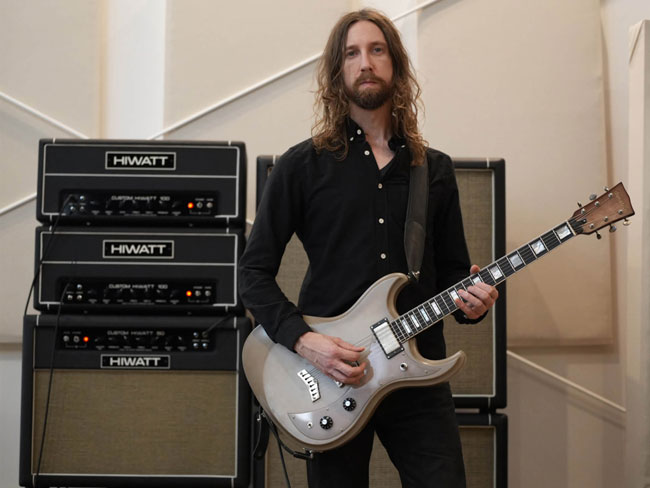
Mike went into great detail and taught me some of the inner workings of post-rock music. If I were to ever make a record, start a band, or whatever, post-rock is the genre I’d love to write. Getting the experience to pick his brain was incredible and I truly appreciate the time. I hope you learn as much as I have from this masterclass musician!
Now, I usually start these with a rig run down so would you mind telling me a little about your gear?
Sure, I use Hiwatt DR103 heads with two Hiwatt 4 x 12 cabs, they are of the Hi-Gain series that have a little more low end and catered to more distortion. The 50 watt combo is a Hiwatt DR504. I run that separately. The two heads and cabs are stereo right and left and the combo is run with its own mic straight down the middle so it can add more punch or be omitted to make the stereo feel more prominent. That’s up to the front of the house to play with. If it comes to rentals, I’m a huge fan of the Hiwatt stuff ever since playing them so it’s all about getting my hands on those. Should we move on to guitars and just move through my rig?
I use Hiwatt DR103 heads with two Hiwatt 4 x 12 cabs, they are of the Hi-Gain series that have a little more low end and catered to more distortion…
Yes, please that sounds perfect!
Okay, for guitars, recently a lot has changed, mostly because of necessity after losing our gear.
Yeah, that’s terrible.
Yeah, the Hiwatts came from that situation though and so did Narwhal guitars by Dunnable. The shape of those are the most ergonomic guitars I’ve owned. Sitting, standing, and the weird positions I find myself in [laughs], the guitar just fits perfectly. It sounds great and I love it. Another one is in the works for alternate tunings on live shows. Those are what I use now for guitars and a whole host of effects which is a beast of its own [laughs]. I’ll break there for a moment before we go into that world.
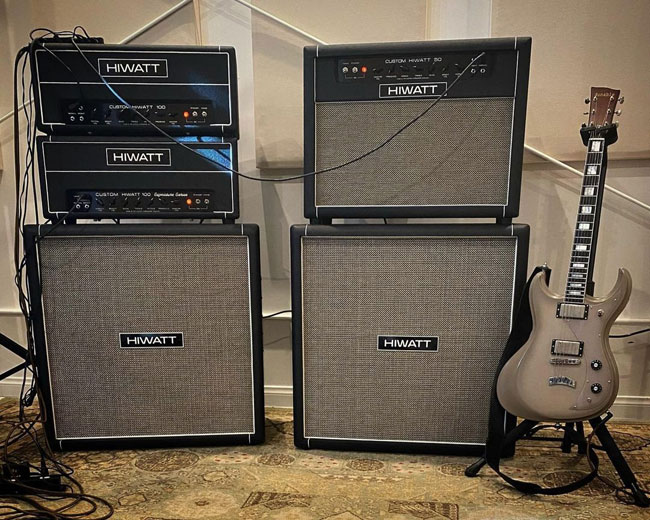
[laughs] I’m very interested in your pedalboard. To touch on guitars though, I’ve been intrigued by Dunnable guitars but I’ve never actually been lucky enough to play one.
They sound cool. The look is fantastic, and they can take on the appearance of retro guitars but at the heart of it, depending on what wood you choose, it can sound as thick as a Les Paul. I’m definitely excited to have another guitar coming in the next week or two.
Very cool. If possible I’ll have to try one! If you would like to dive into your pedalboard now, I’m really interested in what you are currently using!
OK, it’s always changing and since we are going on tour soon, I’m trying to trim the fat a bit. It’s pretty much set now. Starting with gain, I use a Friedman BE-OD Deluxe for two different channels of gain. I also use an Electronic Audio Experiments Halberd. I use that on the record too and I like to use it before the distortion to tighten things up. There is a ton of low-end on it, and it replaced my tube screamer type pedal I had in front of everything because it sounded so good. Those two pedals together make up a big part of the grit. Next is a God City Instruments Jugendstil pedal which is a combination of a fuzz circuit and an HM2 circuit that’s dimed out so you can mix in the EQ. It’s always going to be that exact EQ but you can control how much you want in your signal which is a cool feature.
The shape of those [Dunable] are the most ergonomic guitars I’ve owned…
Then I have an MXR Clyde Wah, an MXR EVH Phase 90 then I have a Dunlop volume pedal. For delay, I’m using a Source Audio Collider which is awesome. I use it to set multiple delays. There’s also reverb on there and a Strymon DIG for delay as well. I also use a Strymon Flint which I actually keep on all the time. There’s something about using it as a boost. I believe it’s the harmonic position I keep it on. That tremolo turned down, and on all the time, brings out the high and low end and it sounds great. I don’t know why that is, but whenever I turn it off, I think ‘no I need that turned back on’. I use an MXR Stereo Chorus, a Digitech JamManLooper and a T-Rex Image Looper. I believe I made it through the board [laughs] other than the A/B boxes to split the signals.
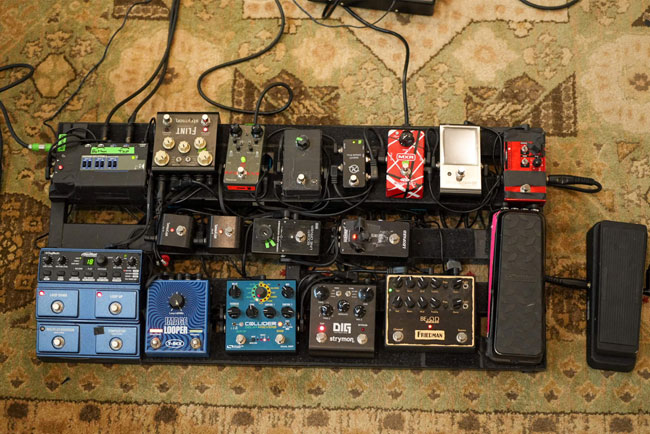
That’s really cool. Why the 2 looper pedals? Is it on for pre-sets and one for live looping?
Yes, exactly. The Image Looper is exclusively for live looping. It’s very ergonomic and painfully simple. Not much room for error live. The JamMan is used for pre-recorded drones that I will pull up in songs, or between songs, and they are all arhythmic texture drones.
** Insert tangent of Mike actually helping me with my setup! **
I interviewed Brian [Cook – bass] a while back and he talked about how the songs in Russian Circles are composed. Can you tell me how you go about writing music and how it has changed for Gnosis?
Yes, for this album in particular, each song was arranged by the person writing the song. It was cool because you got to follow your instinct as opposed to writing the song as a committee. Before, when I had riffs, I wouldn’t pay any attention to what came before or after and we would see how it would fit into a song. This new way was a fun way to write because everything’s on a grid, you’re writing to a click or a drone pattern then you can start building the song in an organized way, then once the song is signed off, that’s when we pass it along to the other bandmates. By the time they’re playing to it, as far as the guitar is concerned, it’s a complete song, then they drop in their parts. It definitely was a first for us to do it like that, it’s from the ground up and brick-by-brick way of writing, before that it was just one mic in a practice space.
This new way was a fun way to write because everything’s on a grid, you’re writing to a click or a drone pattern then you can start building the song in an organized way…
As far as spontaneity, there isn’t a whole lot after the arrangement is set. The riffs were written spontaneously and that was whittled down to make the arrangements for the song. The lightning in the bottle comes from getting the ideas and then we rework them until it’s a complete song. It’s still an exciting way to write. It’s really productive to write to a drum machine, I’ll listen back and pick out the riffs I like and stitch them together. Before you know it, you have half a song and I still do that from time to time when writing heavy riffs.
I just play myself and try and write riffs. Never tried a drum track but I will now.
Open a session and record what you’re doing. Usually, the first thing that comes out is the most creative, after that the magic dwindles and you’re usually trying to chase that original idea. It doesn’t always happen though, so the idea of ‘keep going to the well and eventually you’ll get some water’ is truthful. There are plenty of times that I plug in and play and it generates nothing, so don’t be discouraged, you’re not alone.
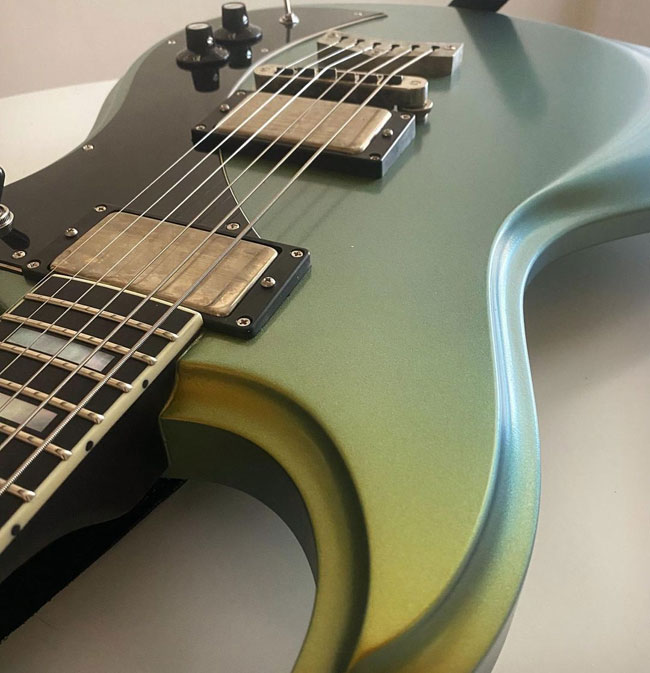
I appreciate that! That goes into my next question of what do you do to get inspired if you’re having an off day?
I’m a fan of learning guitar. I like the feeling of a challenge. I like to learn a classical piece because they’re challenging and there is always a higher bar. I can look back and see what used to give me so much trouble is now no problem. If I’m having a creative block, instead of being frustrated, there are so many other ways to play guitar. I can learn a song, I can learn theory, try one of those classical pieces, all that makes you a well-rounded guitar player and musician. It starts to bleed over into different genres and the way you play, basically, I just like playing. I always have a guitar in my hands and when you have a guitar with you, that’s when good things happen.
Very good advice! I always find myself in a vicious cycle of playing, getting discouraged and stopping for blocks of time, then it’s like I’m starting over sometimes.
Learning a song is difficult but relearning a song isn’t. It may take a few tries but muscle memory kicks in and what may be uncomfortable at first becomes easy quickly because you’ve already done the leg work.
I always have a guitar in my hands and when you have a guitar with you, that’s when good things happen…
That makes sense.
Keep with it!
[Laughs] Yeah, I love it guitar so I always find my way back. Going in the opposite direction what songs or albums are you particularly proud of?
There are some songs I’m more proud of than others and albums as a whole. It has nothing to do with popularity or sales, it’s just some are more personal than others. Some songs are challenging like Ethel, on paper is a complete train wreck [laughs]. The whole song is tapping on guitar, which is a terrible idea, and combined with Dave’s [Turncrantz – drums] shuffle-type drumbeat didn’t make sense but combining those worlds and having Brian reinforcing it with simple root notes turned out well. It’s not something we typically do and having songs that push our boundaries is exciting. I’m also pretty proud of Gnosis. That record felt complete. We got our point across, and everything translated the way we wanted.
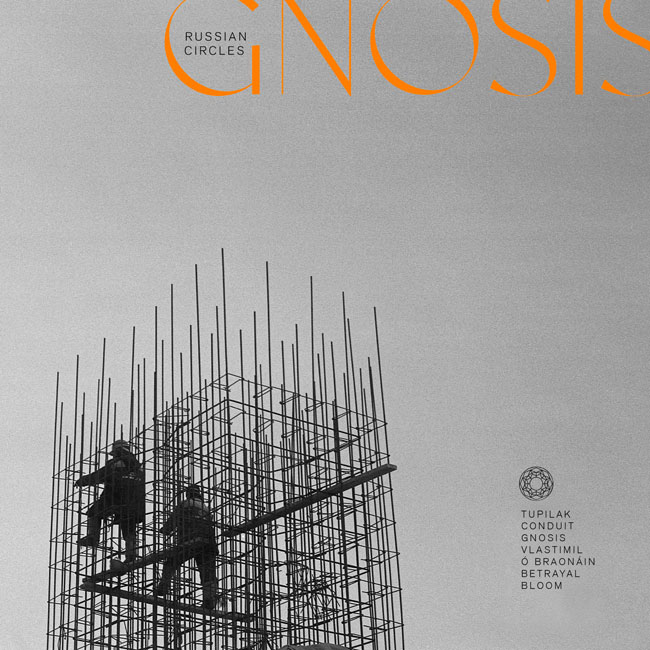
Gnosis is fantastic. It’s often playing anywhere I can play it! What do you listen to for fun?
I’m a creature of habit. If I’m into a record, I’ll listen to it everywhere. It also depends on where I am. If I’m at home, I’ll listen to records more and I’m a lazy listener. If a record is on, I’ll flip it from A to B, back to A and so on [laughs]. I listen to a lot of metal and since the pandemic that has ramped up more. I’ve also been listening to Gábor Szabó, a gypsy jazz guitarist who has some of the best voicings. He has been a great introduction to jazz for me. Jazz has never really been my thing, but I was able to connect with Szabó‘s music.
I like listening to Tinariwen, an African band from Mali, and a lot of the guitarists from that region blow me away. After listening to Goat a lot and seeing what they are into, you can see where the blues came from in Africa and I felt it was so much cooler and had more vibe than the electric bullshit John Mayer type blues. They’re saying so much, and don’t even need to be plugged in. They don’t need effects or a name brand instrument to do it. That style of playing, and the modes and scales they use, for whatever reason, speaks to me.
I like listening to Tinariwen, an African band from Mali, and a lot of the guitarists from that region blow me away…
This is why I ask this question because I like to re-listen to your albums and see if I can pick up some of those influences.
You might be able to. Gnosis for example was originally written as a repetitive Mali blues line as a tribute to that music. The original idea didn’t go over well with the band, but we decided to make it sound more like us by adding delay and various textures. So, in the end, the song was reworked a bit to sound more Russian Circles, but the base idea is still there and if it wasn’t for that influence, the song would never have been written.
This has been an incredible experience and thank you for taking the time to answer ALL my questions. I appreciate it!
Thank you.
Gnosis, the current album from Russian Circles is out now via Sargent House, and keep an eye on the band’s social evil for any upcoming tours, live dates and their latest news.
Label: Sargent House
Band Links: Official | Facebook | Bandcamp | Twitter | Instagram
Interviewed by: Josh Schneider
